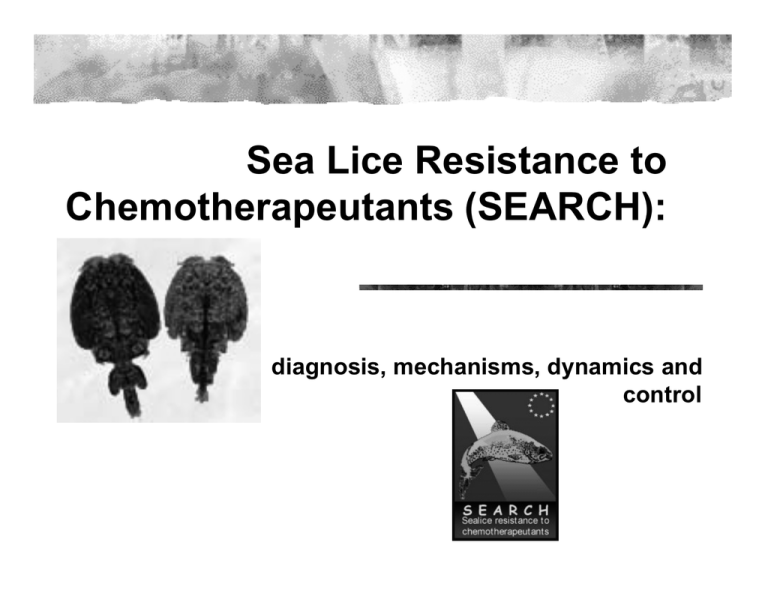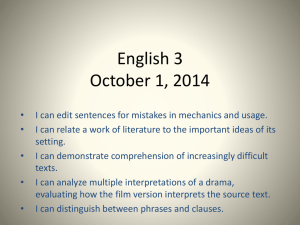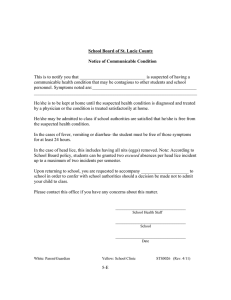Sea Lice Resistance to Chemotherapeutants (SEARCH): diagnosis, mechanisms, dynamics and control
advertisement

Sea Lice Resistance to Chemotherapeutants (SEARCH): diagnosis, mechanisms, dynamics and control Resources 6 partners Norwegian School of Veterinary Science National University of Ireland Galway Irish Marine Institute Institute for Arable Crop Research,Rothamsted Marine Harvest Norway Marine Harvest Scotland University of Prince Edward Island, in collaboration with NRC Institute for Marine Biosciences Period: Jan. 1. 2001 - Jan.1. 2004 Canadian Team: John F. Burka, Ph.D. Larry Hammell, D.V.M., M.Sc. Department of Health Management, Atlantic Veterinary College, UPEI Neil W. Ross, Ph.D. Department of Anatomy & Physiology , Atlantic Veterinary College, UPEI Institute for Marine Biosciences, National Research Council Technical personnel, graduate students, summer students Funding and/or in-kind support EU 5th Framework Programme AquaNet NSERC/NRC Collaborative Research Programme (with Salmon Health Consortium and AVC Inc.) Schering-Plough Animal Health Moore-Clark (Nutreco) New Brunswick Salmon Growers Association Objectives To develop methods for monitoring the development of resistance against chemotherapeutants commonly used for treatment of Lepeophtheirus salmonis in Norway, Scotland, Ireland, and eastern North America Organophosphates Pyrethroids Avermectins 100 90 80 70 60 50 40 30 20 10 0 Org-P. H2O2 Chit.synth.inh . Pyrethroids 19 95 19 96 19 97 19 98 19 99 % Relative treatment intensity year Emamectin Resistance mechanisms for organophosphates and pyrethroids I Enhanced detoxification capacity • Elevated levels of unspecific esterases • Elevated levels of unspecific P450 oxidases I Mutations in genes coding for target proteins, resulting in structural changes OPs Na+ Na+ Na+ Pyr. Na+ Na+ Na+ Factors affecting sea lice treatments with emamectin Oral ingestion Fish must eat medicated feed Concentrations at the site of parasite location Distribution into subcompartments Affected by health of fish, hierarchies, etc. Lipophilic: Emamectin distributed into skin/hypodermic tissues and mucus Sea lice feed on mucus, epidermis, and blood Time of parasite exposure Emamectin requires about a week to achieve sufficient levels in sea lice Sea lice-dependent Larval vs. adult stages P-glycoproteins affect uptake Antiparasitic agents and P-glycoproteins (P-GPs) Avermectins are P-GP substrates P-GPs are responsible for protecting the blood brain barrier of the host from avermectininduced CNS depression P-GPs can be up-regulated in parasites Resistance mechanisms for avermectins Changes in glutamate-gated chloride channels contribute to avermectin resistance in Haemonchus contortus and Drosophila (Paement et al., 1999; Kane et al., 2000) Does alteration in the glu-gated chloride channels occur in sea lice and reduce hyperpolarization? P-GPs are involved in the mechanism of nematode resistance to avermectins (Xu et al., 1998) Does upregulation of P-glycoproteins prevent avermectins from accumulating in sea lice? Approaches to detect and verify resistance I I Efficacy data from full-scale treatments Bioassays • Determination of LC 50 and LC90 (EC50 and EC90 ) I Biochemical methods (only when resistance mechanisms are known) • OP resistance: altered target site (modified AChE) • Enhanced detoxification capacity – Esterases, Oxidases, Etc. I Molecular methods • Organophosphate resistance: altered AChE-gene(s) • Pyrethroid resistance: altered sodium channel gene(s) • Avermectin resistance: altered glu-gated chloride channel gene(s) and/or upregulated P-glycoproteins Project plans Specific plans To develop bioassays capable of detecting resistance towards chemotherapeutants To monitor the effectiveness of sea lice treatments Characterise underlying mechanisms for resistance Develop rapid laboratory methods for diagnosis of resistance Develop genetic markers capable of distinguishing between sea lice populations Monitor patterns of gene flow between farms and regions Monitor spacial and temporal distribution of sensitivity in sea lice populations To develop strategies for the control of resistance Where are we now? Designation of collection sites Sea lice collections: Bay of Fundy Collecting from 4 sea lice populations Saint John Halifax Bioassays Bioassay for azamethiphos Apparent high sensitivity of sea lice to azamethiphos in all samples collected in NB so far Bioassay for emamectin Modifications required – lice need to eat emamectin In progress Epidemiology of lice infestations and treatment efficacy Larry Hammell and Jillian Westcott Field Trial Individually PIT-tag 2200 fish (2001 year class) Obtain lengths, weights and sea lice counts Obtain samples of 30 randomly selected fish for prevalence estimates of selected diseases (ISA and BKD) Tissues obtained and stored for subsequent ISA testing PIT Tag Emamectin Field Trial Estimate effectiveness of emamectin treatments on sea lice counts and weight gains Comparison of individual fish variables on sea lice burdens, ISA and BKD prevalence Comparison of emamectin uptake by different sized fish following treatment Survey of pesticide use in Atlantic Canada salmon aquaculture In progress Emamectin receptor studies Shara Cody and John Burka To determine whether molecular heterogeneity of avermectin receptors exists in sea lice populations Are receptors altered in resistant sea lice? Emamectin transport protein (P-glycoprotein) studies Nick Tribble and John Burka To measure emamectin concentrations in sea lice and differential expression of avermectin transport proteins Do emamectin concentrations in sea lice correlate with resistance?





